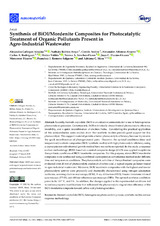Mostrar el registro sencillo del ítem
Synthesis of BiOI/Mordenite Composites for Photocatalytic Treatment of Organic Pollutants Present in Agro-Industrial Wastewater
| dc.contributor.author | Gallegos-Alcaíno, Alejandra | |
| dc.contributor.author | Robles-Araya, Nathaly | |
| dc.contributor.author | Avalos, Camila | |
| dc.contributor.author | Alfonso-Alvarez, Alexander | |
| dc.contributor.author | Rodríguez, Carlos A. | |
| dc.contributor.author | Valdés, Héctor | |
| dc.contributor.author | Sánchez-Flores, Norma A. | |
| dc.contributor.author | Durán-Alvarez, Juan C. | |
| dc.contributor.author | Bizarro, Monserrat | |
| dc.contributor.author | Romero-Salguero, F.J. | |
| dc.contributor.author | Mera, Adriana C. | |
| dc.date.accessioned | 2022-04-01T11:55:16Z | |
| dc.date.available | 2022-04-01T11:55:16Z | |
| dc.date.issued | 2022 | |
| dc.identifier.uri | http://hdl.handle.net/10396/22732 | |
| dc.description.abstract | Recently, bismuth oxyiodide (BiOI) is an attractive semiconductor to use in heterogeneous photocatalysis processes. Unfortunately, BiOI individually shows limited photocatalytic efficiency, instability, and a quick recombination of electron/holes. Considering the practical application of this semiconductor, some studies show that synthetic zeolites provide good support for this photocatalyst. This support material permits a better photocatalytic efficiency because it prevents the quick recombination of photogenerated pairs. However, the optimal conditions (time and temperature) to obtain composites (BiOI/ synthetic zeolite) with high photocatalytic efficiency using a coprecipitation-solvothermal growth method have not yet been reported. In this study, a response surface methodology (RSM) based on a central composite design (CCD) was applied to optimize the synthesis conditions of BiOI/mordenite composites. For this purpose, eleven BiOI/mordenite composites were synthesized using a combined coprecipitation-solvothermal method under different time and temperature conditions. The photocatalytic activities of the synthesized composites were evaluated after 20 min of photocatalytic oxidation of caffeic acid, a typical organic pollutant found in agro-industrial wastewater. Moreover, BiOI/mordenite composites with the highest and lowest photocatalytic activity were physically and chemically characterized using nitrogen adsorption isotherms, scanning electron microscopy (SEM), X-ray diffraction (XRD), Fourier transform infrared spectroscopy (FT-IR), and diffuse reflectance spectroscopy (DRS). The optimal synthesis conditions prove to be 187 °C and 9 h. In addition, the changes applied to the experimental conditions led to surface property modifications that influenced the photocatalytic degradation efficiency of the BiOI/mordenite composite toward caffeic acid photodegradation. | es_ES |
| dc.format.mimetype | application/pdf | es_ES |
| dc.language.iso | eng | es_ES |
| dc.publisher | MDPI | es_ES |
| dc.rights | https://creativecommons.org/licenses/by/4.0/ | es_ES |
| dc.source | Nanomaterials 12(7), 1161 (2022) | es_ES |
| dc.subject | Bismuth oxyiodide (BiOI) | es_ES |
| dc.subject | Heterogeneous photocatalytic process | es_ES |
| dc.subject | Synthetic zeolite | es_ES |
| dc.subject | Surface response methodology | es_ES |
| dc.title | Synthesis of BiOI/Mordenite Composites for Photocatalytic Treatment of Organic Pollutants Present in Agro-Industrial Wastewater | es_ES |
| dc.type | info:eu-repo/semantics/article | es_ES |
| dc.relation.publisherversion | https://doi.org/10.3390/nano12071161 | es_ES |
| dc.relation.projectID | Gobierno de España. RTI2018-101611-B-I00 | es_ES |
| dc.relation.projectID | Junta de Andalucía. FQM-346 | es_ES |
| dc.rights.accessRights | info:eu-repo/semantics/openAccess | es_ES |

